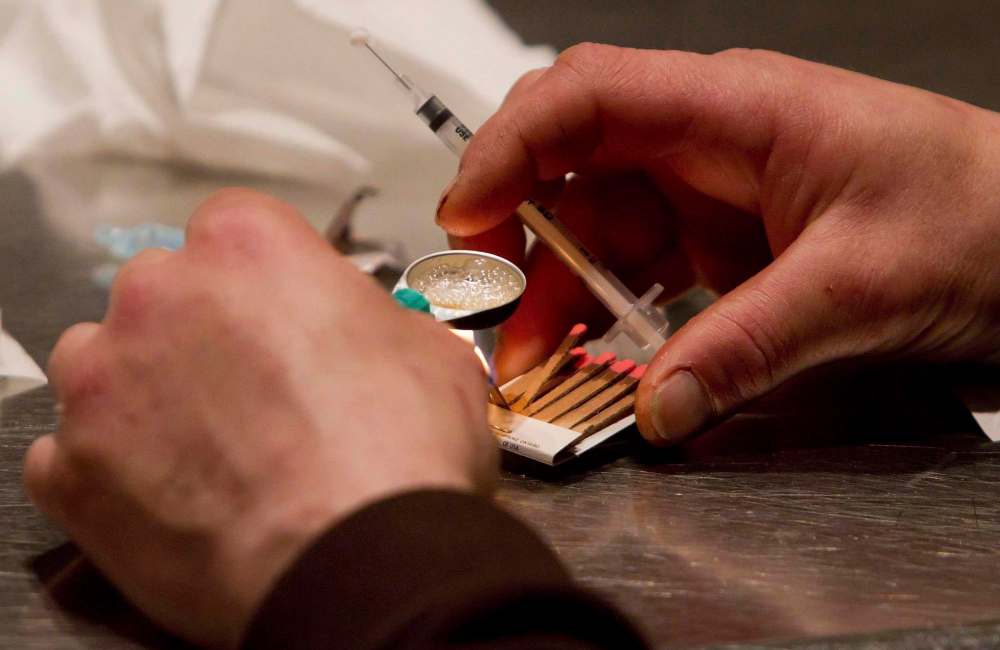Manitoba unreceptive to safe injection sites, despite Ottawa’s intention to make them easier to establish
Advertisement
Read this article for free:
or
Already have an account? Log in here »
To continue reading, please subscribe:
Monthly Digital Subscription
$1 per week for 24 weeks*
- Enjoy unlimited reading on winnipegfreepress.com
- Read the E-Edition, our digital replica newspaper
- Access News Break, our award-winning app
- Play interactive puzzles
*Billed as $4.00 plus GST every four weeks. After 24 weeks, price increases to the regular rate of $19.00 plus GST every four weeks. Offer available to new and qualified returning subscribers only. Cancel any time.
Monthly Digital Subscription
$4.75/week*
- Enjoy unlimited reading on winnipegfreepress.com
- Read the E-Edition, our digital replica newspaper
- Access News Break, our award-winning app
- Play interactive puzzles
*Billed as $19 plus GST every four weeks. Cancel any time.
To continue reading, please subscribe:
Add Free Press access to your Brandon Sun subscription for only an additional
$1 for the first 4 weeks*
*Your next subscription payment will increase by $1.00 and you will be charged $16.99 plus GST for four weeks. After four weeks, your payment will increase to $23.99 plus GST every four weeks.
Read unlimited articles for free today:
or
Already have an account? Log in here »
Hey there, time traveller!
This article was published 13/12/2016 (3234 days ago), so information in it may no longer be current.
Ottawa’s announcement Monday to make it easier to establish safe injection sites hasn’t changed Manitoba Health Minister Kelvin Goertzen’s mind — his answer is still no.
The province’s position has less to do with the rules and more to do with evidence sites have a positive impact on harm reduction, Goertzen said in an interview Tuesday afternoon. He said he has not seen evidence providing a Winnipeg or Manitoba context.
Safe injection sites showing a positive impact capture “a relatively small geographic footprint,” essentially a very concentrated area of drug users unwilling to walk more than two blocks to a site, Goertzen said. That type of concentration doesn’t exist in Winnipeg.

“That regrettably is the case in Vancouver — there is that concentration there,” he said.
Goertzen cautioned safe injection sites aren’t cheap to operate and there is a limited amount of resources available for harm reduction. However, he said the safe needle exchange program has worked well and, starting in January, the province is increasing the availability of naloxone, particularly in rural Manitoba.
Naloxone can be an effective antidote to fentanyl overdoses.
Meanwhile, the John Howard Society is leading a small but growing movement hoping to establish at least one safe injection site in Winnipeg.
Executive director John Hutton said Tuesday it is terrific the federal government moved to make it easier for communities to establish safe injection sites.
“It’s based on need, and that’s terribly important,” Hutton said, adding it moves addiction from a criminal issue to a health issue. “It really frames the issue in a positive way — it’s a health issue.”
Hutton said he’s already talked to Klinic, and will soon be contacting other community health and social services agencies.
“We’re concerned we’ll see more overdoses affecting our clients,” said Hutton, whose national organization works with people who are incarcerated and helps integrate them back into society. “It would make sense to have a clinic close to where folks are already using. Expecting people to get on a bus and travel wouldn’t make sense.”
Klinic executive director Nicole Chammartin said her agency supports the Canadian Community Health Association’s position: “There is overwhelming clinical and public health evidence that demonstrates that supervised injection services (SIS) save lives and, where included in a national drug strategy, provide a low threshold gateway into the health system.”
NDP health critic Matt Wiebe said it’s essential a safe injection site not only provide sterile needles and clean and safe surroundings, but also access to health services and counselling and must be supervised.
“It certainly opens the door. I’m very excited the federal government is going out as far as it is,” Wiebe said. “It’s a tool communities can use. They’re looking at harm reduction in any form they can find it. You can bring in some of the most marginalized folks.”
However, others are not yet eager to go as far, though they’re monitoring what’s happening.
“At this point, we have not seen evidence that a safe-injection site would benefit those who use illicit drugs in Winnipeg,” said Bronwyn Penner-Holigroski, senior communications specialist with the Winnipeg Regional Health Authority. It is something we continue to discuss and monitor, but we would need to do a thorough evaluation of the needs of the population who use illicit drugs before undertaking such a process.
“That process would need to be undertaken with our partners at the province and with the City of Winnipeg. We have not had specific requests or proposals from partners, but we are monitoring the situation closely as the concern around fentanyl continues to grow.”
Despite Ottawa’s announcement on Monday, Goertzen cautioned federal legislation to make it easier to establish a safe injection site is months away from being passed, and any site would need provincial approval.
nick.martin@freepress.mb.ca


